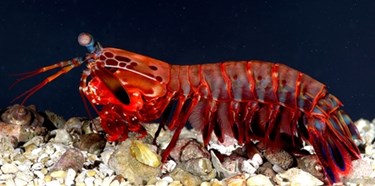Mantis Shrimp's Sophisticated Eyes Guide Novel Camera Design
By Jof Enriquez,
Follow me on Twitter @jofenriq

Researchers at the University of Illinois at Urbana-Champaign have built a unique point-and-shoot color-polarization camera inspired by the highly-complex visual system of the mantis shrimp. This new imaging system with a little-understood mechanism of polarization can be used in many ways, including the monitoring of underwater species and detecting early signs of cancer.
Mantis shrimp — marine crustaceans of the order Stomatopoda — have fascinated photonics scientists for the animals' impressive ability to communicate safely using the polarization of light, without alerting predators. The mantis shrimp's bright reflectors are known to polarize light by manipulating light across the structure, rather than through its depth, which is how typical polarizers work.
Perhaps even more impressive are the mantis shrimp's eyes, which are one of the most sophisticated visual systems in the animal kingdom. Each eye has 16 different types of color receptors and six polarization channels. By contrast, a human eye has only three color receptors. The eyes of the mantis shrimp have trinocular vision (three focal points), can see both in the ultraviolet and the infrared, and are capable of high polarization sensitivity and hyperspectral imaging.
“These organs not only surpass the sensitivity of our own visual systems, they also capture more visual information, using less power and space, than today’s most sophisticated, state-of-the-art cameras,” said Viktor Gruev, an associate professor in the department of Electrical Engineering at University of Illinois at Urban Campaign.
Grueve and graduate student Missael Garcia sought to mimic this advanced and elegant natural visual system with the development of a single-chip, low-power, high-resolution color-polarization camera, using a combination of conventional silicon and newer nanomaterials.
“The same laws of physics that apply to the mantis visual system also apply to silicon materials, the material used to build our digital cameras,” said Garcia. “By stacking multiple photodiodes on top of each other in silicon, we can see color without the use of special filters. And by combining this technology with metallic nanowires, we effectively have replicated the portion of the mantis shrimp visual system that allows it to sense both color and polarization.”
The camera's features were described in a recent issue of Optica.
“Our bio-inspired imager comprises 1280 by 720 pixels with a dynamic range of 62 dB and a maximum signal-to-noise ratio of 48 dB. The quantum efficiency is above 30 percent over the entire visible spectrum, while achieving high polarization extinction ratios of ~40 on each spectral channel,” wrote the scientists.
The impetus behind the research — sponsored by the National Science Foundation and the Air Force Office of Scientific Research — is to build a cost-effective diagnostic imaging solution for early cancer detection. Gruev had developed a similar bioinspired polarization sensor that was fitted to a colonoscope to detect cancerous cells in the human colon.
In addition, the researchers say their new imaging technology inspired by the mantis shrimp will allow scientists to better understand how other marine species use light to communicate.
